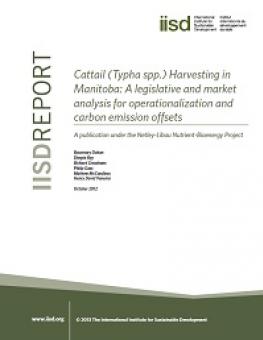
Cattail (Typha spp.) Harvesting in Manitoba: A legislative and market analysis for operationalization and carbon emission offsets
Research findings from the Netley-Libau Nutrient-Bioenergy project are encouraging replication of the cattail harvesting concept in areas in the Manitoba, Minnesota and North Dakota regions of the Lake Winnipeg watershed.
It is also increasingly being seen as a component of an integrated nutrient and surface water management plan. As a result of this replication, there is a need to understand and synthesize the legislative and policy implications in Manitoba of the harvesting of cattails (Typha spp.) and other potential plants or ecological biomass with similar benefits (i.e., Phragmites reeds, reed canary grass, willows). This analysis will ensure that the operationalization of these new value chains as part of a Manitoba bioeconomy includes sustainable processes for due diligence. It also ensures that these value chains are subject to appropriate oversight to ensure that social, economic and environmental needs and concerns are balanced in the best way possible.
This report presents a legislative review of cattail (Typha spp.) harvesting in Manitoba. Our review found that the harvest of cattails and other similar ecological biomass is not currently explicitly included in any federal or provincial legislation, policy or programming. This study provides some research and analysis to understand the current and potential positions of cattail harvesting in Manitoba. Based on our review, we present two management scenarios in this report that include legislation, policies and programming:
- A private benefit harvesting scenario based on other resource extraction programs similar to for-profit activities like wild rice harvesting. This scenario is relevant for both Crown and private lands.
- A publicly funded land management assistance scenario, where private corporations are contracted to harvest cattails in areas of concern. This scenario can be used on Crown lands in this way, or for private lands using incentives such as those used for agricultural beneficial management practices or other tax credits to land owners.
You might also be interested in
How can we improve on freshwater health and prevent plastic pollution?
INC-4 is the fourth meeting in a series of international negotiations that aims to develop a global treaty on plastic pollution that could and should have big implications for freshwater quality both in Canada and beyond.
Northwest Ontario Side Story: IISD Experimental Lakes Area Annual Report 2022-2023
This year's annual report is a celebration of all things creative at the world's freshwater laboratory, from the science to music, photography and theatre.
Freshwater connectivity can transport environmental DNA through the landscape
A new study conducted at IISD-ELA found that the movement of water between freshwater bodies can transport eDNA which complicates the question of how accurately it can be used to monitor species.
Microplastics now pervasive in Great Lakes, with 90% of water samples surpassing safe levels for aquatic wildlife: new studies
Data spanning the last ten years reveal that the Great Lakes basin is widely contaminated with microplastics, with potentially dangerous consequences for the wildlife that live within.